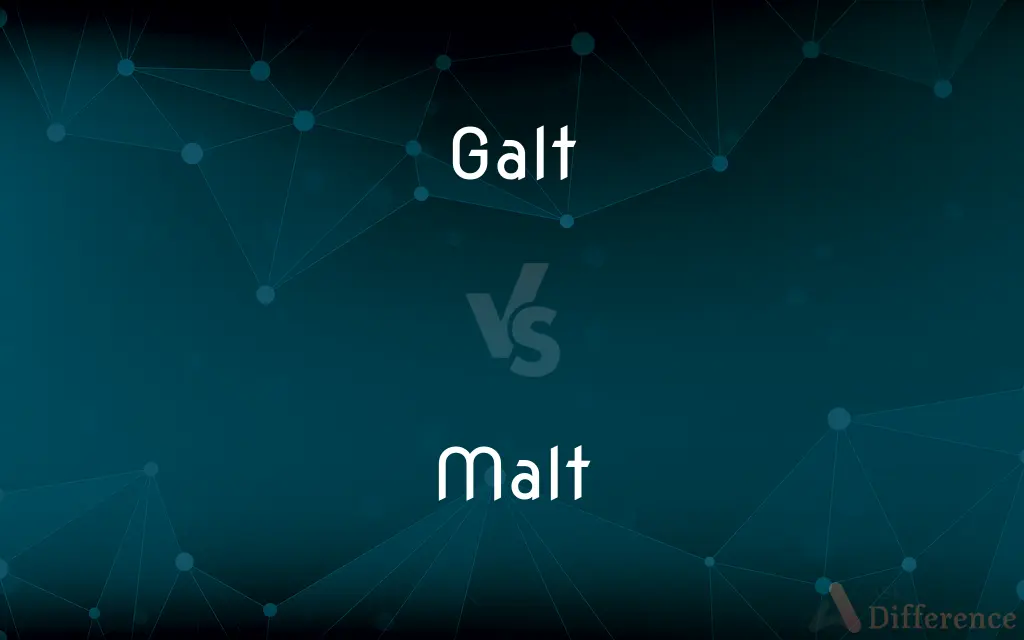Galt vs. Malt — What's the Difference?
By Urooj Arif & Fiza Rafique — Updated on March 15, 2024
Galt refers to a measurement or locality, rarely used in common parlance, whereas malt is a germinated cereal grain used in brewing, distilling, and food production, known for its role in flavoring beverages like beer.

Difference Between Galt and Malt
Table of Contents
ADVERTISEMENT
Key Differences
Galt is not a commonly used term in everyday language; it may refer to specific measurements in historical contexts or to places named "Galt" in certain regions. On the other hand, malt is widely recognized in the food and beverage industry, particularly in brewing and distilling, where it serves as a foundational ingredient. Malt is made by germinating cereal grains, which are then dried in a process called malting. This process activates enzymes necessary for converting the grain's starches into sugars, essential for fermentation.
While galt's relevance might be limited to historical, geographical, or specific technical contexts, malt plays a crucial role in the production of beer, whiskey, and various food products. Its significance lies in its ability to contribute flavor, color, and the sugars needed for fermentation. In contrast, the term "galt" lacks a universal application or importance in everyday activities or industries.
The production and use of malt underscore its importance in culinary and beverage manufacturing, highlighting a process that has been refined over centuries. Malt's contribution to the flavor profile of beers and whiskeys is particularly noteworthy, as it provides the sweet, toasty base that defines many classic styles. Galt, by comparison, does not pertain to a widespread process or product and is therefore less likely to be encountered in discussions of food, beverage, or general interest.
Malt has a significant place in various traditions around the world, associated with brewing and distilling practices that date back thousands of years. It is emblematic of the rich history of human culinary evolution, whereas galt, if mentioned, would likely reference specific local histories or technical specifications in niche fields.
Comparison Chart
Definition
A term referring to measurement or locality
Germinated cereal grains used in brewing and food production
ADVERTISEMENT
Common Usage
Historical, geographical contexts
Brewing, distilling, and culinary applications
Significance
Limited to specific contexts
Essential ingredient for flavor and fermentation in beverages
Process
Not applicable
Involves germination and drying of grains
Cultural Impact
Minimal, unless referencing specific local histories
Significant, with a rich tradition in brewing and distilling
Compare with Definitions
Galt
May refer to specific measurements in certain contexts.
The galt measurement was used in trade in the 18th century.
Malt
Adds flavor, color, and fermentable sugars to beverages.
The malt gives the beer its golden hue and sweet taste.
Galt
A term with historical or geographical significance.
Galt was a prominent figure in the development of the town.
Malt
Undergoes a specific process called malting.
The grains are soaked in water to begin the malt process.
Galt
Specific to certain locations or technical fields.
Galt, Ontario, is known for its historical significance.
Malt
Germinated cereal grains used in brewing and distilling.
The brewery sources its malt from local farmers.
Galt
Rarely used in everyday language.
The term galt appears in some historical documents of the region.
Malt
Essential for beer and whiskey production.
Malt contributes to the distinctive flavor of the ale.
Galt
Not widely recognized in contemporary discussions.
Few people today are familiar with the meaning of galt.
Malt
Has a rich tradition in culinary and beverage history.
Malt has been used in brewing since ancient times.
Galt
Alternative form of gault
Malt
Malt is germinated cereal grain that has been dried in a process known as "malting". The grain is made to germinate by soaking in water and is then halted from germinating further by drying with hot air.Malting grain develops the enzymes (α-amylase, β-amylase) required for modifying the grains' starches into various types of sugar, including monosaccharide glucose, disaccharide maltose, trisaccharide maltotriose, and higher sugars called maltodextrines.
Galt
Same as Gault.
Malt
Grain, usually barley, that has been allowed to sprout, used chiefly in brewing and distilling.
Malt
An alcoholic beverage, such as beer or ale, brewed from malt.
Malt
See malted milk.
Malt
To process (grain) into malt.
Malt
To treat or mix with malt or a malt extract.
Malt
To become malt.
Malt
Malted grain sprouted grain (usually barley), used in brewing and otherwise.
Malt
Malt liquor, especially malt whisky.
Malt
A milkshake with malted milk powder added for flavor.
Malt
Maltose-rich sugar derived from malted grain.
Malt
(transitive) To convert a cereal grain into malt by causing it to sprout (by soaking in water) and then halting germination (by drying with hot air) in order to develop enzymes that can break down starches and proteins in the grain.
Malt
(intransitive) To become malt.
Malt
To drink malt liquor.
Malt
Barley or other grain, steeped in water and dried in a kiln, thus forcing germination until the saccharine principle has been evolved. It is used in brewing and in the distillation of whisky.
Malt
Relating to, containing, or made with, malt.
Malt
To make into malt; as, to malt barley.
Malt
To become malt; also, to make grain into malt.
Malt
A milkshake made with malt powder
Malt
A lager of high alcohol content; by law it is considered too alcoholic to be sold as lager or beer
Malt
A cereal grain that is kiln-dried after having been germinated by soaking in water; used especially in brewing and distilling
Malt
Treat with malt or malt extract;
Malt beer
Malt
Turn into malt, become malt
Malt
Convert grain into malt
Malt
Convert into malt
Common Curiosities
How is malt produced?
Malt is produced by germinating cereal grains and then drying them in a process that activates enzymes for sugar conversion.
What is galt primarily associated with?
Galt can refer to specific measurements or localities, often within historical or geographical contexts.
Does galt have any relevance in food and beverage?
Galt does not have a recognized role or significance in the food and beverage industry.
What is the historical significance of malt?
Malt has a long history in human culinary practices, especially in brewing and distilling, dating back thousands of years.
What makes malt important in brewing?
Malt provides essential sugars needed for fermentation, along with flavor and color to beer and whiskey.
Can galt and malt be related in any context?
Generally, galt and malt do not relate directly to each other, belonging to entirely different contexts.
Is galt a technical term?
In the contexts where it is used, galt may refer to specific technical measurements or denote particular localities.
Can galt be found in common discussions?
No, galt is rarely used in everyday language and is more likely to appear in specific historical or geographical references.
What types of beverages use malt?
Malt is used in the production of beer, whiskey, and other malted beverages.
How does malt influence the taste of beer?
Malt contributes sweet, toasty, and sometimes caramel notes to beer, forming the beverage's flavor foundation.
Is there a modern use for the term galt?
Modern use of galt is very limited, mostly pertaining to historical interest or specific place names.
What grains are typically malted?
Barley is the most common grain for malting, though wheat, rye, and others can also be malted for specific beverage types.
What is the cultural impact of malt?
Malt plays a significant role in cultural traditions related to brewing and distilling, reflecting its importance in culinary evolution.
Why is malting important for fermentation?
Malting activates enzymes in grains that convert starches into fermentable sugars, which are vital for alcohol production during fermentation.
How does malt contribute to whiskey's flavor?
In whiskey, malt provides a range of flavors from sweet and malty to smoky, depending on the malting process.
Share Your Discovery

Previous Comparison
Cowslip vs. Oxlip
Next Comparison
Bird vs. ChickAuthor Spotlight
Written by
Urooj ArifUrooj is a skilled content writer at Ask Difference, known for her exceptional ability to simplify complex topics into engaging and informative content. With a passion for research and a flair for clear, concise writing, she consistently delivers articles that resonate with our diverse audience.
Co-written by
Fiza RafiqueFiza Rafique is a skilled content writer at AskDifference.com, where she meticulously refines and enhances written pieces. Drawing from her vast editorial expertise, Fiza ensures clarity, accuracy, and precision in every article. Passionate about language, she continually seeks to elevate the quality of content for readers worldwide.














































